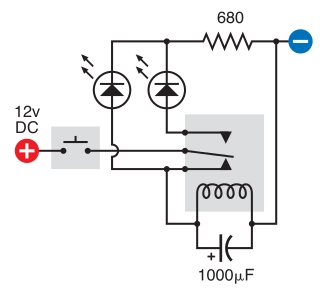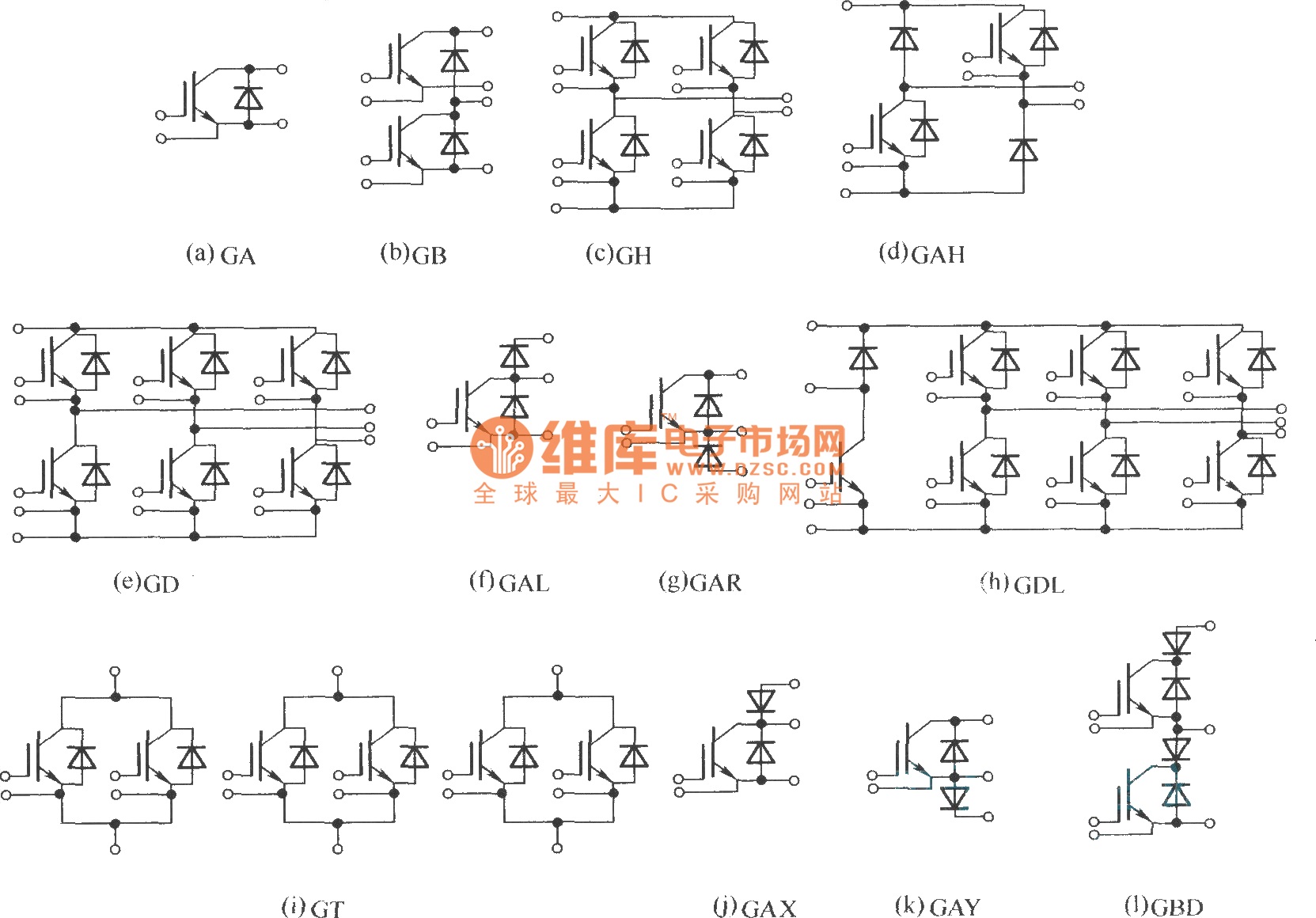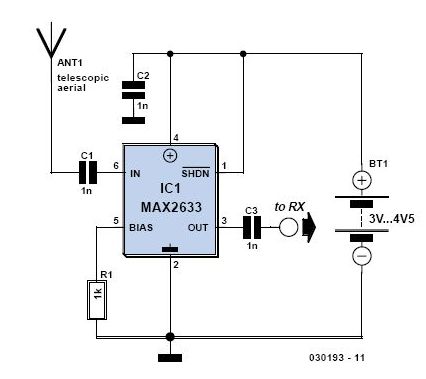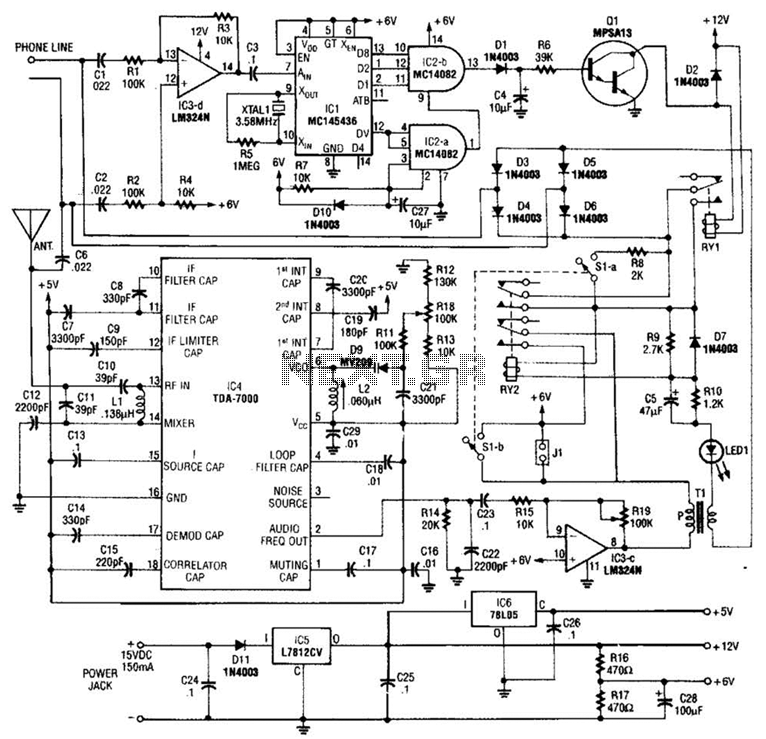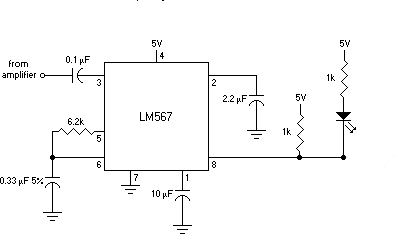
Laser Diode Circuit
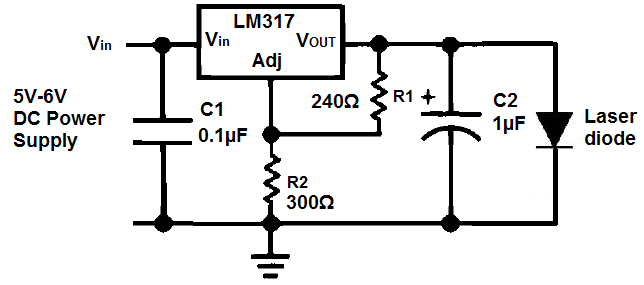
Unlike LED light, a laser's light output is more concentrated, resulting in a smaller and narrower viewing angle. This characteristic necessitates that the laser light be directed more precisely at its source for effective detection. Laser light is also monochromatic, meaning it consists of a single wavelength rather than a combination of multiple colors. For instance, green light produced by LEDs is typically a combination of blue and yellow light. In contrast, laser light maintains a single spectral color, representing one of the purest forms of monochromatic light available. Laser diodes find applications in CD players, CD-ROM drives, laser printers, laser fax machines, laser pointers, measurement equipment, barcode scanners, and various high-performance imaging systems. A driver circuit is essential for controlling the current supplied to the laser diode, ensuring it operates correctly. Excess current can damage the diode, while insufficient current may prevent it from functioning. The LM317 adjustable voltage regulator is utilized for this purpose, requiring a heat sink to dissipate the heat generated during operation. For example, if 6V is input to the regulator and it outputs 3V, the difference of 3V is dissipated as heat. A heat sink allows this heat to dissipate safely into the air, protecting sensitive components. The input DC voltage can range from 5V to 6V, with the possibility of using up to 9V when a heat sink is employed. This input can be supplied by a DC power supply set to 5V, four AA batteries for 6V, or a 9V battery with a heat sink. The initial capacitor, a 0.1µF ceramic capacitor, filters out high-frequency noise, while the second capacitor, a 1µF electrolytic capacitor, balances power loads and smooths out fluctuations. Two resistors are configured to output approximately 2.8V, with a 300Ω resistor suitable for demonstration purposes. This resistor can be replaced with a potentiometer to adjust the laser diode's brightness. However, different laser diodes may have varying voltage and current requirements. To determine the necessary output voltage from the LM317 regulator, the LM317 Voltage and Resistor Calculator can be utilized. To monitor the current flowing through the circuit, a multimeter set to the DC ammeter setting can be used. By breaking the circuit at the anode of the laser diode and the anode of the capacitor, the current can be measured. A minimum current of 20mA, known as the threshold current, is required to activate the laser diode, while a typical operating current of 40mA is recommended for optimal performance. The maximum allowable current for the diode is specified as 60mA; exceeding this limit can damage the diode. Adhering to the specifications outlined in the datasheet is crucial for safe operation.
The laser diode operates under specific electrical parameters that must be adhered to for optimal performance. The LM317 voltage regulator is pivotal in maintaining the required current levels while preventing damage to the diode. The heat sink is integral in managing the thermal load generated during operation, particularly when there is a significant difference between the input and output voltages. It is essential to calculate the appropriate resistor values to ensure the laser diode receives the correct voltage and current. Using the LM317 Voltage and Resistor Calculator can aid in this process by providing the necessary resistor values based on the desired output voltage.
In practical applications, it is advisable to verify the actual current flowing through the circuit using a multimeter, particularly when setting up the circuit for the first time. This ensures that the current is within the specified limits for the diode and prevents accidental damage. The use of a potentiometer allows for fine-tuning of the brightness, providing flexibility in applications where adjustable light intensity is required. It is also essential to consider the specifications in the laser diode's datasheet, which provides critical information on the maximum ratings and operational parameters to ensure reliability and longevity of the device. Overall, careful attention to the design and implementation of the driver circuit will lead to successful operation of the laser diode in various applications.Unlike LED light, a laser`s light output is more concentrated, meaning it has a smaller and more narrow viewing angle. This means it must be directed at its source more directly in order to be picked up. Laser light is also monochromatic, meaning laser light isn`t composed of several lights combined together, but one light of the same wavelength a
nd energy. Normally with LEDs, the different light outputs are based upon different colors combined. One such example is green light. To output green light, blue and yellow lights are combined to give green. Lasers, for the most part, do not follow this. Laser lights have a single spectral color and is almost the purest monochromatic light available. Laser diodes are used in CD players, CD-ROM drives, and other optical storage drives. They are used in laser printers, laser fax machines, laser pointers, measurement equipment, bar-code and UPC scanners, and in high-performance imagers, as well as various other applications. These are just the most popular and used aspects of them. A driver circuit is a circuit which can limit appropriately the amount of current being fed into the laser diode, so that it can function correctly.
Too much current and the laser diode will blow. Too little current and the laser diode will not have sufficient power to turn on and operate. Therefore, a driver circuit is needed to give precisely the correct range of current needed so that our diode will operate. The type of regulator we will use is the LM317 adjustable voltage regulator. The reason we need a heat sink is to dissipate excess heat created by the regulator. For example, if we input 6V into the regulator and it only regulators out 3V, this means that 6V-3V= 3V is dissipated as heat energy.
To safely get rid of this excess heat energy, we connect the voltage regulator to a heat sink so that the excess heat dissipates into the air rather than damage sensitive electronic components. For our input DC voltage, we can use anywhere from 5V-6V as our DC input. With a heatsink, even more voltage can be used such as up to 9V, since the heatsink will ensure that the difference in input and output voltage will be safely dissipated away as heat.
For this DC input, we can either use a DC power supply and set it to output 5V or we can use 4 `AA` batteries for 6V input or a 9V battery if used with a heatsink. The first capacitor, the 0. 1G‚ µF ceramic capacitor, serves to filter out high-frequency noise from the DC power supply. The second capacitor, the 1G‚ µF electrolytic, serves as a power load balancer to smooth out fluctuating signals.
The 2 resistors R will output approximately 2. 8V. So a 300G resistor will be perfect for our application for demonstration purposes. Later on, you can swap out this resistor for a potentiometer to vary the laser diode voltage to increase the brightness or dim it, as to how desired. However, if you are using a different laser diode, it may have different voltage and current requirements.
To calculatoe the output voltage needed output from the LM317 regulator, see the LM317 Voltage and Resistor Calculator. This calculator can find the R Just so that you can see the operating requirements of the laser diode, these are snippets of the datasheet.
If you want to see the PDF of the datasheet, click on the datasheet link below. To check the current flowing through the circuit, you an take a multimeter and place it in the DC ammeter setting. Break the circuit opening right at the anode of the laser diode and the anode of the capacitor and measure the amount of current flowing through.
At least 20mA is needed for the laser diode to turn on. This is called the threshold current; it again represents the minimum amount of current needed for the diode to function. However, more typically, the operating current is used for a decent amount of power output. For this diode, the typical operating current is 40mA. So 40mA should be fed. To increase or decrease resistance, you can change the value of resistance R. Increasing this resistance value increases current. Conversely, decreasing this value decreases current. The maximum amount of current which the laser diode should receive is specified by its maximum operating current, which in with this diode is 60mA.
No more than 60mA should be fed into the diode or the diode may be destroyed. So make sure to always follow the datasheet specifications. 🔗 External reference
The laser diode operates under specific electrical parameters that must be adhered to for optimal performance. The LM317 voltage regulator is pivotal in maintaining the required current levels while preventing damage to the diode. The heat sink is integral in managing the thermal load generated during operation, particularly when there is a significant difference between the input and output voltages. It is essential to calculate the appropriate resistor values to ensure the laser diode receives the correct voltage and current. Using the LM317 Voltage and Resistor Calculator can aid in this process by providing the necessary resistor values based on the desired output voltage.
In practical applications, it is advisable to verify the actual current flowing through the circuit using a multimeter, particularly when setting up the circuit for the first time. This ensures that the current is within the specified limits for the diode and prevents accidental damage. The use of a potentiometer allows for fine-tuning of the brightness, providing flexibility in applications where adjustable light intensity is required. It is also essential to consider the specifications in the laser diode's datasheet, which provides critical information on the maximum ratings and operational parameters to ensure reliability and longevity of the device. Overall, careful attention to the design and implementation of the driver circuit will lead to successful operation of the laser diode in various applications.Unlike LED light, a laser`s light output is more concentrated, meaning it has a smaller and more narrow viewing angle. This means it must be directed at its source more directly in order to be picked up. Laser light is also monochromatic, meaning laser light isn`t composed of several lights combined together, but one light of the same wavelength a
nd energy. Normally with LEDs, the different light outputs are based upon different colors combined. One such example is green light. To output green light, blue and yellow lights are combined to give green. Lasers, for the most part, do not follow this. Laser lights have a single spectral color and is almost the purest monochromatic light available. Laser diodes are used in CD players, CD-ROM drives, and other optical storage drives. They are used in laser printers, laser fax machines, laser pointers, measurement equipment, bar-code and UPC scanners, and in high-performance imagers, as well as various other applications. These are just the most popular and used aspects of them. A driver circuit is a circuit which can limit appropriately the amount of current being fed into the laser diode, so that it can function correctly.
Too much current and the laser diode will blow. Too little current and the laser diode will not have sufficient power to turn on and operate. Therefore, a driver circuit is needed to give precisely the correct range of current needed so that our diode will operate. The type of regulator we will use is the LM317 adjustable voltage regulator. The reason we need a heat sink is to dissipate excess heat created by the regulator. For example, if we input 6V into the regulator and it only regulators out 3V, this means that 6V-3V= 3V is dissipated as heat energy.
To safely get rid of this excess heat energy, we connect the voltage regulator to a heat sink so that the excess heat dissipates into the air rather than damage sensitive electronic components. For our input DC voltage, we can use anywhere from 5V-6V as our DC input. With a heatsink, even more voltage can be used such as up to 9V, since the heatsink will ensure that the difference in input and output voltage will be safely dissipated away as heat.
For this DC input, we can either use a DC power supply and set it to output 5V or we can use 4 `AA` batteries for 6V input or a 9V battery if used with a heatsink. The first capacitor, the 0. 1G‚ µF ceramic capacitor, serves to filter out high-frequency noise from the DC power supply. The second capacitor, the 1G‚ µF electrolytic, serves as a power load balancer to smooth out fluctuating signals.
The 2 resistors R will output approximately 2. 8V. So a 300G resistor will be perfect for our application for demonstration purposes. Later on, you can swap out this resistor for a potentiometer to vary the laser diode voltage to increase the brightness or dim it, as to how desired. However, if you are using a different laser diode, it may have different voltage and current requirements.
To calculatoe the output voltage needed output from the LM317 regulator, see the LM317 Voltage and Resistor Calculator. This calculator can find the R Just so that you can see the operating requirements of the laser diode, these are snippets of the datasheet.
If you want to see the PDF of the datasheet, click on the datasheet link below. To check the current flowing through the circuit, you an take a multimeter and place it in the DC ammeter setting. Break the circuit opening right at the anode of the laser diode and the anode of the capacitor and measure the amount of current flowing through.
At least 20mA is needed for the laser diode to turn on. This is called the threshold current; it again represents the minimum amount of current needed for the diode to function. However, more typically, the operating current is used for a decent amount of power output. For this diode, the typical operating current is 40mA. So 40mA should be fed. To increase or decrease resistance, you can change the value of resistance R. Increasing this resistance value increases current. Conversely, decreasing this value decreases current. The maximum amount of current which the laser diode should receive is specified by its maximum operating current, which in with this diode is 60mA.
No more than 60mA should be fed into the diode or the diode may be destroyed. So make sure to always follow the datasheet specifications. 🔗 External reference
